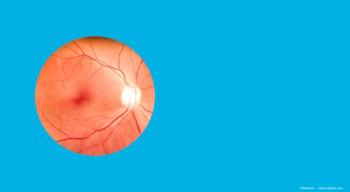
Keys to assessing true crosslinking outcomes
Virtual Bowman's topography software provides a new noninvasive way to look at crosslinking outcomes.
This article was reviewed by Gairik Kundu, MBBS, MS
A novel method of noninvasively evaluating the outcomes after crosslinking is under development. The software that can be plugged into existing topographers will become commercially available in the near future.
“A decade after crosslinking was developed, the question remains about what actually determines the true outcomes of crosslinking; is it flattening or the demarcation line? We have numerous topographers available, but what are we missing?” asked Gairik Kundu, MBBS, MS, a fellow, Department of Cornea and Refractive Surgery, Narayana Nethralaya, Bangalore, Karnataka, India.
An important consideration regarding topographers is how perfect the technology is and what are their limitations. Some devices are based on Scheimpflug and others on Placido. Placido devices can image the anterior but not the posterior corneal surface; however, the technology it is affected by changes in corneal irregularities and alterations of the ocular surface. The Scheimpflug camera does not have sufficient resolution to delink the epithelium from the surface of Bowman’s layer, according to Dr. Kundu.
“It is important for us to understand that the current topographers cannot dissociate the epithelium,” he said
Another extremely important factor to consider after crosslinking is that the epithelium might be a “masquerader,” Dr. Kundu suggested.
“Is the epithelium the confounder? Is this the factor that we are not actually looking at?” he asked.
The epithelium, he pointed out, can change after crosslinking. The curvature at the air/epithelium interface will differ from that at the epithelium/Bowman’s interface.
“Knowing this, are we seeing the actual outcomes?” Dr. Kundu asked.
Not all outcomes after crosslinking are necessarily the desired ones. This can happen as the result of progression. This is the point at which surgeons must question what is being measured and what should be measured.
“Are we looking at the air/epithelium interface?” Dr. Kundu asked. “In most cases, this is the masquerader that actually masks the changes that are taking place beneath.”
The study
Dr. Kundu and colleagues conducted a study to assess the true outcomes after crosslinking. The method that he proposed to accomplish this is by using a virtual de-epithelialization technique that he and his colleagues developed, i.e., a noninvasive way of delinking the epithelium from the Bowman’s surface beneath.
The basis for the study was the recognition that the previous work described in the literature required an invasive procedure to evaluate Bowman’s layer. The epithelium had to be removed intraoperatively before the topography could be assessed.
The investigators analyzed 40 eyes of 40 patients with keratoconus, all of whom had undergone crosslinking. The Pentacam and anterior-segment optical coherence tomography (OCT) data were collected preoperatively and postoperatively.
They used the Optovue spectral-domain OCT and obtained eight radial two-dimensional frames using MATLAB software, which facilitated viewing of the air/epithelium and the epithelium/Bowman’s interface.
“These raw elevation points were then translated into cartesian points and we determined the tangential and axial curvature data,” Dr. Kundu explained. “We then performed a ray tracing method and Zernike analysis to calculate the aberrations. This is how we arrived at the air/epithelium and the epithelium/Bowman’s interface.”
Study findings
The research team’s results showed that the Bowman’s surface was actually more than 1 D steeper than the air/epithelium surface, which was a significant difference (p < 0.05).
When they evaluated the Pentacam curvature data, the investigators found that the air/epithelium interface determined by OCT was similar to the Pentacam anterior surface data.
“However, when we went deeper and looked at the Bowman’s surface, it was much steeper,” Dr. Kundu noted.
When they evaluated the aberration profiles, they observed that the Bowman’s surface higher-order and lower-order aberrations were significantly higher than those determined from the air/epithelial surface.
Considerations
The investigators questioned if this could help them in evaluating crosslinking outcomes postoperatively.
Dr. Kundu explained that when they determined the degree of flattening from preoperatively to postoperatively of the anterior surface followed by the stromal surface, they found that the Bowman’s surface had 55% more flattening compared to the air/epithelium interface. He recounted a case in which the anterior surface topography after crosslinking flattened by about 1.05 D.
“When we applied our algorithm and used the virtual de-epithelialization technique the flattening was found to be actually more than 2 D six months postoperatively,” he said.
In a second case, the anterior surface flattening was about 3.5 D after crosslinking, but Bowman’s surface had flattened by almost 1 D.
The future
Dr. Kundu pointed out two known factors: the curvature is known to be steeper on the stromal surface compared with the anterior surface, and that the stromal changes are masked by the epithelial thickness and haze that hide that crosslinking outcomes.
The current study added four important points, according to Dr. Kundu.
“This method provides a non-invasive way to quantify tomographic features at the Bowman’s surface and early detection of diseases and progression,” he concluded. “Bowman’s surface actually shows the real crosslinking outcomes. This method facilitates customized treatments and prevention of unnecessary retreatments in patients with keratoconus.”
Gairik Kundu, MBBS, MS
E: [email protected]
This article was adapted from Dr. Kundu's presentation at the 2019 meeting of the American Academy of Ophthalmology. Dr. Kundu has no financial interest in this technology. This paper was awarded Best of Session.
Newsletter
Don’t miss out—get Ophthalmology Times updates on the latest clinical advancements and expert interviews, straight to your inbox.


















































.png)


